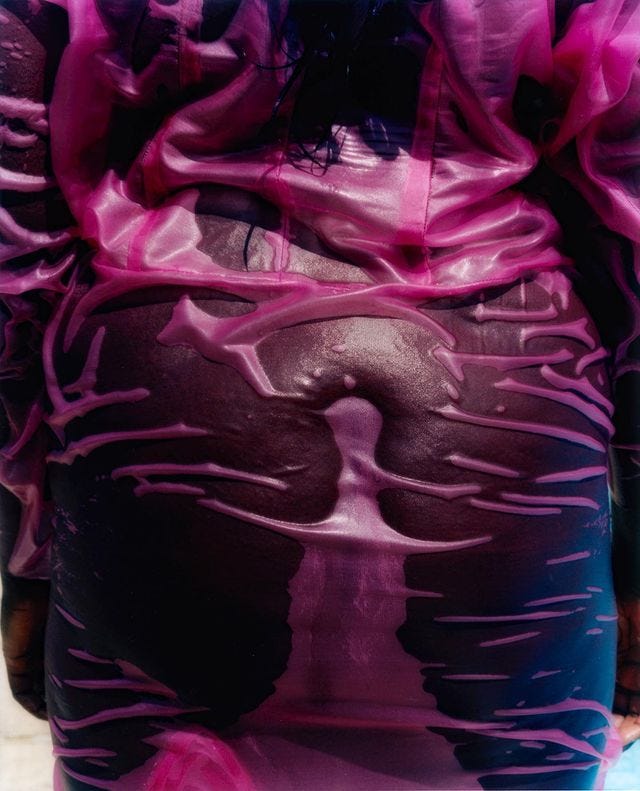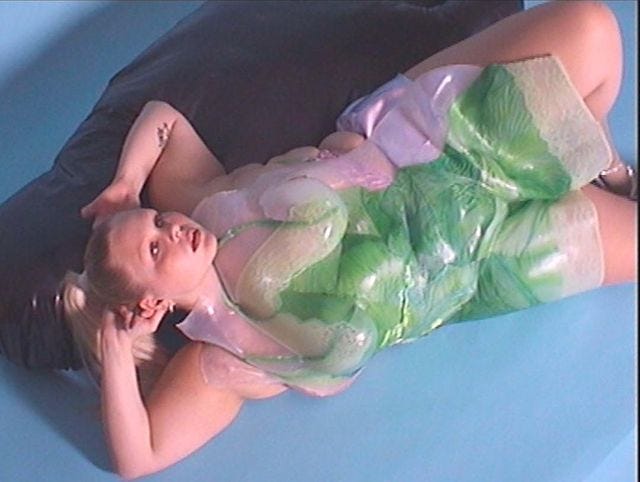Your weekly exploration of art and its mediums. The stories we tell and the ways we tell them.
A collection of things I’ve seen, this weeks story I first saw on Instagram and then got the privilege of seeing on the opening night of its gallery show.
Sinéad O’Dwyer is a fashion designer and artist based in London. O’Dwyer creates molds that deal with female body dysmorphia and the fragile and often tense relationships we have with our bodies. Her work sits somewhere between fashion and art, if the two can be separated at all. It is this dichotomy that made O’Dwyer’s show at the New York art gallery, Waves and Archives, so exciting to the fashion world.
I attended the opening event of O’Dwyer’s show with friends and it felt very much like we were not supposed to be there. We weren’t, for a variety of reasons but seeing her pieces in person is the only way that one should see them. There is more complexity brought out in them when your own body stands next to the molds. A contemplation and conversation that you are forced to have with yourself and the clothing you wear.
The molds are usually of close friends who she calls her muses. People who’s bodies she has come to know intimately. In an interview with Cultured Magazine she says, “I’ve had lots of conversations with them [muses], and there’s this history of stories, stories that have been woven around them, the narrative of their body based on what they feel about it, and also what other people have kind of injected.” O’Dwyer criticizes the fashion world and designers for their hypocrisy. They will talk about how inspiring the human body is without ever looking at it and instead using mannequins or pre-decided measurements for patterns.
“I wanted to create garments where the body was actually, literally, there, without changing it.”
She says that her clothes tell the stories of individual bodies rather than making universal claims about it. If you don’t know the body intimately or through the eyes of a lover or of a doctor, like O’Dwyer strives to, it is easy to make generalizations about the body and it’s person.
O’Dwyer’s work is a statement against the fashion industry’s choice to make clothes the easy way. Cutting patterns on very flat bodies means that when it was time to make a larger size one would just add a couple more numbers to the initial measurements. O’Dwyer plays with the idea that when you are buying a piece of clothing, you are wearing someone else’s body on top of your own. Wearing someone else’s story and the way that clothing gathers on their arms. Her work is the literal version of this idea.
If you can’t translate your idea to size 24, is it really an interesting or relevant one?”
The flatness that clothing is modeled against is not reflective of the conventional sized female, who’s body will create different lines of movement throughout our lifetimes. The stagnation of clothing, she says, makes us live in fear of change in our bodies and the inevitable possibility of no longer fitting into those fabric patterns.
I find it interesting still that she recognizes a lack of movement or progression in clothing and still creates the clothes in a material that cannot move with you. Because it isn’t about the clothing it is about the body that molds it. So whether it is molded against a different body or molded against yours, it’s about revealing what industries are so keen to hide.
O’Dwyer makes the fiber glass as thin as possible to embed garments inside which create beautiful textures and compressions on the final mold. I think it can also be seen as the way that clothing, that is not made with your body in mind, will gather and scrunch within the mold. Embedding these garments into the mold combines the two opposing conversations, something made of the body and something that is not.
Sinéad’s work makes me excited for everything else that comes out of non-complacency within the fashion industry. I do worry that its classification of fashion/art will make it out of reach for the people that are impacted by the kinds of discriminations that her work addresses and works to balance. I worry mostly because I too would like to stretch and move in pieces of art.
Note: O’Dwyer is working on what ready-to-wear pieces would look like in the store, she says it will mostly likely be a whole lot of shirring and elastic to let the body shape the pieces instead of the other way around.
Be well, Readers.
For more information:
“Wear Me Like Water”, O’Dwyer’s short film for her SS20 collection








